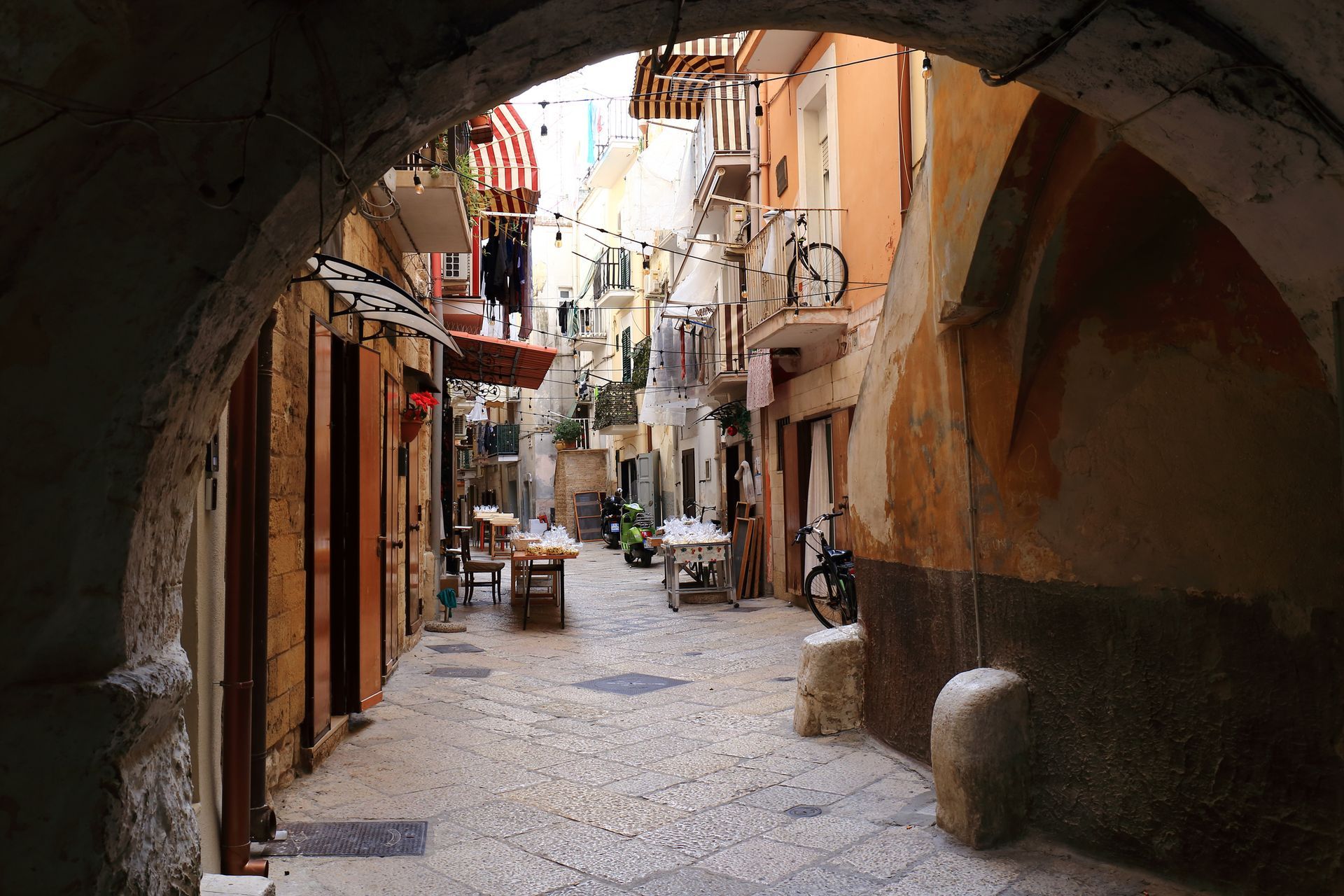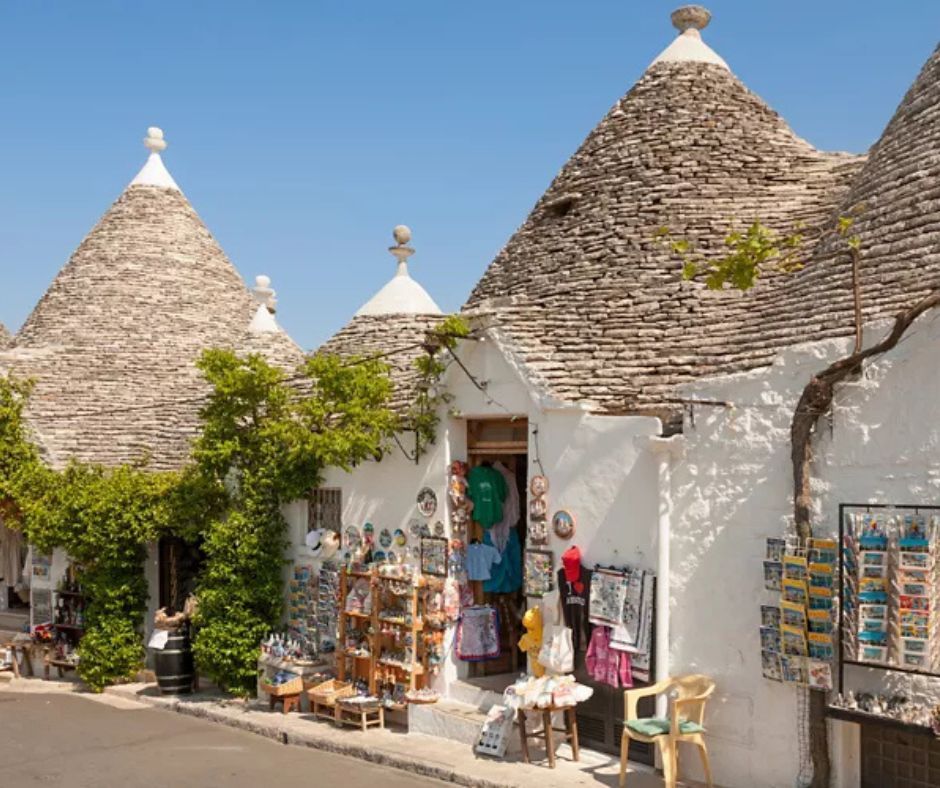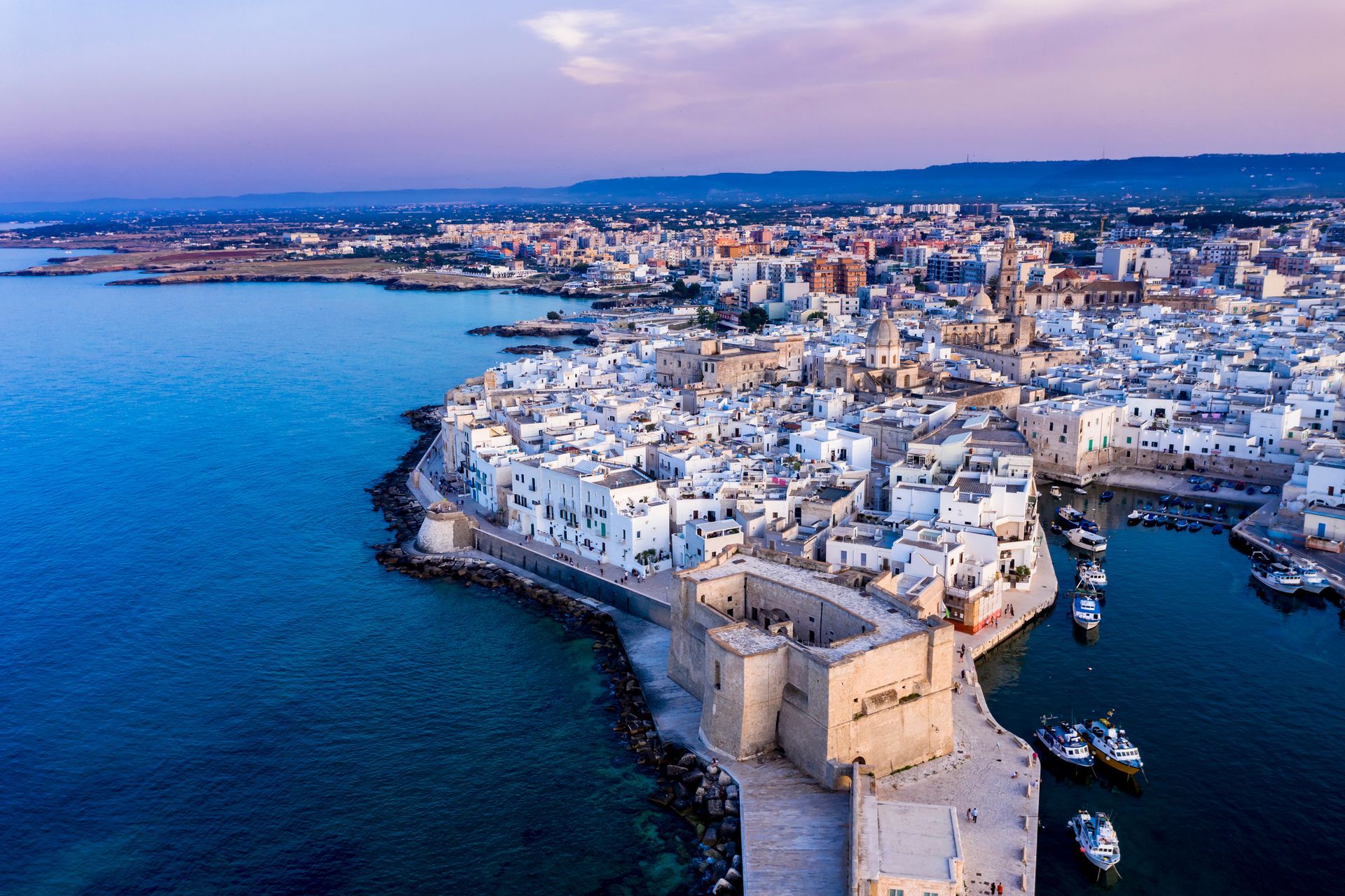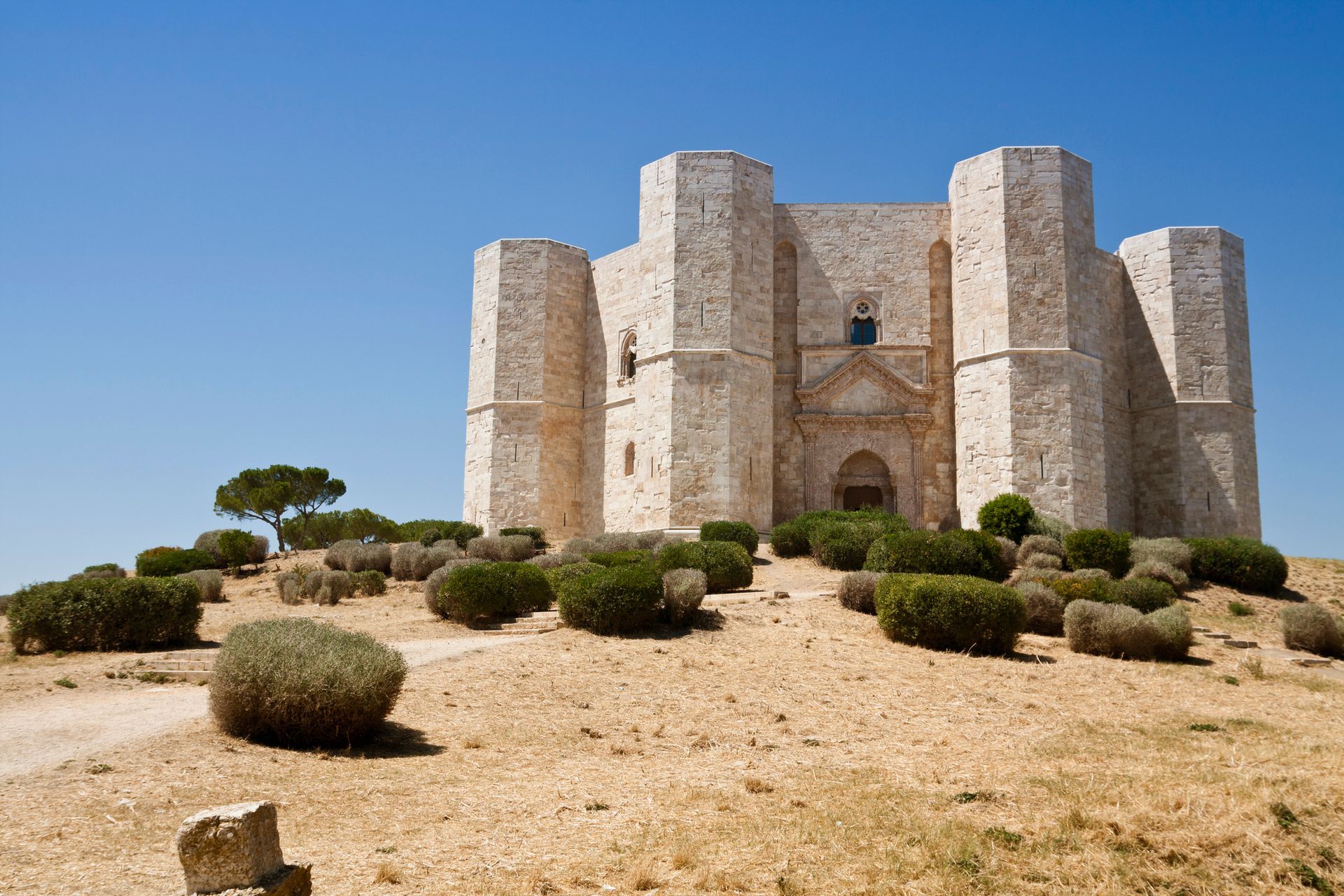What to visit in Bari and its surroundings
Discover the wonders of Puglia
Hotel Adria is located in a strategic position that makes it particularly convenient for guests. It is located in the immediate vicinity of the train station and public transport, allowing you to move around easily. Thanks to this favourable position, you can easily reach the main points of interest in Bari and its surroundings, thus exploring the wonders of Puglia, with its fascinating landscapes and its historical and cultural riches. Whether you want to visit the city of Bari, the splendid beaches or the characteristic villages, Hotel Adria represents the ideal starting point for your adventures.
Discover Bari: an Italian treasure between history and sea
A Bari proverb says: "If Paris had the sea, it would be a little Bari." Although this may seem a bit exaggerated, it reflects the love and respect that the people of Bari have for their city.
Bari may not be Paris, but it is still a beautiful city in southern Italy, full of attractions and wonders just a few kilometres from the centre. A great starting point to explore the city is the waterfront, considered one of the most beautiful in Italy, which offers breathtaking views of the crystal clear sea of Puglia.
Two of the main historical buildings in Bari are the Church of San Nicola, also known as Santa Claus's house, and the Swabian-Norman Castle, one of the most important Romanesque monuments in the country.
For those who want to immerse themselves in the authentic spirit of Bari, a visit to Bari Vecchia is a must. During the day, it is the ancient and popular heart of the capital of Puglia, while at night, it transforms into a trendy place for young people.
Basilica of Saint Nicholas
The Basilica of San Nicola in Bari is one of the most important and fascinating religious buildings in Italy.
Saint Nicholas of Myra, patron saint of Bari, is loved by both Catholics and Orthodox.
Legend has it that this is the original figure of Santa Claus, our Father Christmas.
The Church of St. Nicholas in Bari houses his remains in the crypt, making it a
place of pilgrimage for both Catholic and Russian Orthodox believers. It is one of the few places of worship in Italy where the functions of both rites are celebrated.
Built in 1089 to house the remains of the Saint, the basilica is today one of the most visited places in Puglia, worth a visit for several reasons. It is a magnificent example of Romanesque style, with gilded wooden ceilings painted in the 17th century, a silver altar and a
ciborium from 1150, the oldest in Puglia. The Chair of Elijah is one of the most representative Romanesque sculptures in the region.
The treasure of Saint Nicholas, which continues to grow thanks to donations and ex-votos from the faithful, is kept in the Museo Nicolaiano, adjacent to the basilica, and includes silverware, illuminated manuscripts and precious parchments.
Opening hours of the Basilica of San Nicola:
Every day from 7:00 a.m. to 8:30 p.m.
Sunday until 10 p.m.
Ticket price:
Entrance to the museum: €3 (full price), €2 (reduced)

Swabian Castle
Built on the foundations of the original castle commissioned by Roger the Norman in 1131, the current Norman-Swabian castle was completely destroyed in 1156 then rebuilt in 1223 at the request of Frederick II of Swabia.
Today, as it did a thousand years ago, the Norman-Swabian castle dominates the old town of Bari, protecting its main entrance and overlooking the sea.
In addition to its great historical value, the castle houses the Superintendence for the Environmental, Architectural and Historical Heritage of Puglia and is one of the most important Romanesque monuments in Italy.
The building is composed of two distinct parts: the Mastio, rebuilt by Frederick II, which includes two of the original towers and another part with bastions and turrets added in 1500.
And a bridge over the moat greets visitors at the entrance, where they can admire a Gothic portal and a Renaissance courtyard.
On the ground floor, the castle houses a gallery of plaster casts with casts of the most important monuments of Puglia.
Norman-Swabian Castle opening hours:
Every day from 9:00 a.m. to 7:00 p.m.
Closed on Mondays.
Ticket price: €6.
Swabian Castle
Built on the foundations of the original castle commissioned by Roger the Norman in 1131, the current Norman-Swabian castle was completely destroyed in 1156 then rebuilt in 1223 at the request of Frederick II of Swabia.
Today, as it did a thousand years ago, the Norman-Swabian castle dominates the old town of Bari, protecting its main entrance and overlooking the sea.
In addition to its great historical value, the castle houses the Superintendence for the Environmental, Architectural and Historical Heritage of Puglia and is one of the most important Romanesque monuments in Italy.
The building is composed of two distinct parts: the Mastio, rebuilt by Frederick II, which includes two of the original towers and another part with bastions and turrets added in 1500.
And a bridge over the moat greets visitors at the entrance, where they can admire a Gothic portal and a Renaissance courtyard.
On the ground floor, the castle houses a gallery of plaster casts with casts of the most important monuments of Puglia.
Norman-Swabian Castle opening hours:
Every day from 9:00 a.m. to 7:00 p.m.
Closed on Mondays.
Ticket price: €6.
The seafront by Bari
The Bari waterfront, inaugurated in 1927, is today one of the most famous promenades in the city. Here you can admire at a glance a series of late Art Nouveau buildings and breathe in the unique atmosphere of Bari, with its green parks and the breathtaking view of the Adriatic.
The best known part of the waterfront includes Via Imperatore Augusto, Via Araldo di Crollalanza and Via Nazario Sauro, stretching from the new port to the old port.
Along the way, a passage through the city walls allows you to discover the old town. Inside the waterfront are some of the most beautiful buildings in Bari, such as the Albergo delle Nazioni, the Kursaal Santa Lucia Theatre, the Palazzo della Provincia and the Petruzzelli Theatre.

Old Bari
The San Nicola district, known to its inhabitants as Bari Vecchia, stretches between the city's two ports, the old and the new, and overlooks the waterfront. It is the historic heart of Bari. The heart of Bari Vecchia dates back to the Middle Ages, is surrounded by walls and dominated by the Norman-Swabian castle, one of the distinctive symbols of Puglia.
At night, Bari Vecchia comes alive with a special charm. Walking through the labyrinth of its alleys, it seems as if time has stopped: on the doorsteps of the houses, women prepare the famous orecchiette with water, semolina and knives, the houses are huddled together, and at every corner you discover churches, monuments and picturesque views of the sea.
Located in this area, the Basilica of San Nicola is an architectural masterpiece. Equally fascinating is the Cathedral of San Sabino, dating back to 1100, which houses a precious medieval illuminated manuscript.
Walking along the "chianche" (large cobblestones) in the heart of Bari Vecchia, it is possible to discover at least a dozen other churches, in an atmosphere that seems suspended in time. In this place where everyone knows each other, the smells of the kitchens mingle with the sea breeze.
Also not to be missed is the Fort of Sant'Antonio Abate, built in 1300 for defensive purposes. Bari Vecchia is the centre of the nightlife: along the walls, young people and families meet to stroll and enjoy the evening.
Old Bari
The San Nicola district, known to its inhabitants as Bari Vecchia, stretches between the city's two ports, the old and the new, and overlooks the waterfront. It is the historic heart of Bari. The heart of Bari Vecchia dates back to the Middle Ages, is surrounded by walls and dominated by the Norman-Swabian castle, one of the distinctive symbols of Puglia.
At night, Bari Vecchia comes alive with a special charm. Walking through the labyrinth of its alleys, it seems as if time has stopped: on the doorsteps of the houses, women prepare the famous orecchiette with water, semolina and knives, the houses are huddled together, and at every corner you discover churches, monuments and picturesque views of the sea.
Located in this area, the Basilica of San Nicola is an architectural masterpiece. Equally fascinating is the Cathedral of San Sabino, dating back to 1100, which houses a precious medieval illuminated manuscript.
Walking along the "chianche" (large cobblestones) in the heart of Bari Vecchia, it is possible to discover at least a dozen other churches, in an atmosphere that seems suspended in time. In this place where everyone knows each other, the smells of the kitchens mingle with the sea breeze.
Also not to be missed is the Fort of Sant'Antonio Abate, built in 1300 for defensive purposes. Bari Vecchia is the centre of the nightlife: along the walls, young people and families meet to stroll and enjoy the evening.
Bari Metro
For those who wish to explore Bari from a unique perspective and immerse themselves in its rich history, Bari Sotterranea offers a guided night tour in the company of accredited archaeologists. The tour begins in the dungeons of the Norman-Swabian castle and crosses the entire old underground city.
During
the night guided tour it is possible to reconstruct the life of Bari from its first settlements, with a hut dating back to the Bronze Age, through the Roman era and the glorious period of the capital of the Byzantine Empire in the West, when Christian and Byzantine churches stood nearby and houses and shops developed around them, as is the case today in Bari Vecchia.
The guided tour of
Bari Sotterranea clearly shows how the entire old town developed on successive layers: houses and churches were built on the remains of previous structures, and even today you can find tombs, pottery and remains of hearths. For example, the basement of the Basilica of San Nicola hides an ancient early Christian basilica.
Bari Metro opening hours:
Meet every Sunday at 11:00 a.m.,
Ticket price:
25€ for the visit of approximately 2 hours

The Trulli of Alberobello near Bari
Alberobello, known as the city of trulli, is located about 55 km from Bari. Although the trulli, symbol of Puglia, are present in other areas of the region, only those of Alberobello have been recognised as a World Heritage Site by UNESCO, making this place a fairy tale.
Trulli have existed in Puglia since prehistoric times and are dry stone constructions, made of limestone, abundant in the region, with conical roofs made of horizontal slabs that taper towards the top.
On the roofs of the trulli you can see strange white symbols, superstitious and propitiatory signs.
These buildings are not only fascinating and characteristic, but they also have many qualities: they are self-supporting (the beams inside were used to hang tools, not to support the structure) and represent a perfect example of passive ecological construction. Thanks to the thickness of the walls and the absence of openings, except for a small skylight and the door, the trulli retain heat in winter and remain cool in summer.
In Alberobello, we recommend you visit the locality "Monti", which has over a thousand trulli, including two twin trulli. In Via Monte Pertica, there is the church of Sant'Antonio, the only church made up of trulli, while in Piazza Sacramento you can visit the Trullo Sovrano, a two-storey trullo that today houses a museum.
The Trulli of Alberobello near Bari
Alberobello, known as the city of trulli, is located about 55 km from Bari. Although the trulli, symbol of Puglia, are present in other areas of the region, only those of Alberobello have been recognised as a World Heritage Site by UNESCO, making this place a fairy tale.
Trulli have existed in Puglia since prehistoric times and are dry stone constructions, made of limestone, abundant in the region, with conical roofs made of horizontal slabs that taper towards the top.
On the roofs of the trulli you can see strange white symbols, superstitious and propitiatory signs.
These buildings are not only fascinating and characteristic, but they also have many qualities: they are self-supporting (the beams inside were used to hang tools, not to support the structure) and represent a perfect example of passive ecological construction. Thanks to the thickness of the walls and the absence of openings, except for a small skylight and the door, the trulli retain heat in winter and remain cool in summer.
In Alberobello, we recommend you visit the locality "Monti", which has over a thousand trulli, including two twin trulli. In Via Monte Pertica, there is the church of Sant'Antonio, the only church made up of trulli, while in Piazza Sacramento you can visit the Trullo Sovrano, a two-storey trullo that today houses a museum.
Polignano a Mare
You can't imagine a guide on what to see in the Bari area without mentioning Polignano a Mare, a jewel in the blue. This village, known nationally and internationally, is famous for its postcard images, with cliffs overlooking the sea and caves—fascinating natural features created by water erosion and wave movement. The poetry that permeates the alleys of Polignano is the same that inspired Domenico Modugno, born here in 1928.
A place not to be missed is the
beach of Lama Monachile, also known as
Cala Porto, one of the most famous in all of Puglia. This beach, born in the bed of an ancient stream, is today one of the most picturesque views of the city. For a spectacular view of Lama Monachile, we recommend reaching the
Ponte Borbonico, 15 metres high and overlooking the beach. Right here is the
Via Traiana, built by the Emperor Trajan to connect Rome to Brindisi.

Monopoli
Monopoli, a charming coastal town, is known for its beautiful beaches and rich history. With its picturesque old town, characterised by narrow cobblestone streets and whitewashed buildings, Monopoli offers a glimpse into traditional Italian culture. Visitors are often fascinated by the crystal-clear waters of the Adriatic Sea that surround the town, making it a popular destination for swimmers and water sports enthusiasts.
Monopoli truly embodies the beauty and vibrancy of southern Italy, making it a must-visit for anyone exploring the region.
Monopoli
Monopoli, a charming coastal town, is known for its beautiful beaches and rich history. With its picturesque old town, characterised by narrow cobblestone streets and whitewashed buildings, Monopoli offers a glimpse into traditional Italian culture. Visitors are often fascinated by the crystal-clear waters of the Adriatic Sea that surround the town, making it a popular destination for swimmers and water sports enthusiasts.
Monopoli truly embodies the beauty and vibrancy of southern Italy, making it a must-visit for anyone exploring the region.
Castellana Caves
With over
3 km of trails and a depth of over 100 metres, the Castellana Caves are among the most spectacular cave complexes in Italy. Located about 44 km from Bari, they are famous for the White Grotto, known as
the most splendid alabaster cave in the world.
The tour goes down to 7 metres deep and offers two types of routes. Special routes are offered for people with physical and mental disabilities, as well as night tours, events and concerts.
The cave complex also includes a museum and an astronomical observatory.
The entire route lasts about two hours and starts from La Grave, the largest cave in the system with its 100 metres of length, the only one with natural access to the surface. We continue through canyons, stalactites and stalagmites with amazing shapes and colours, crossing environments with evocative names such as the Wolf, the Altar and the Precipice, until reaching the
White Cave, the deepest and most fascinating.
Opening hours of the Castellana Caves:
Tours available every day from 9:00 a.m. to 6:00 p.m., with different times depending on the type of tour chosen.
Ticket price:
Full tour in Italian: €19.50 per person.

Mont Castle
Do you remember the symbol chosen for the one cent coin? It is Castel del Monte, a 13th-century fortress built by Frederick II of Swabia and famous for its octagonal plan. Thanks to its importance, Castel del Monte was declared a World Heritage Site by UNESCO in 1996. Today it is easily reachable by car in about half an hour from Andria and in an hour from Bari. It is one of the must-see destinations that we definitely include in what to see near Bari.
Mont Castle
Do you remember the symbol chosen for the one cent coin? It is Castel del Monte, a 13th-century fortress built by Frederick II of Swabia and famous for its octagonal plan. Thanks to its importance, Castel del Monte was declared a World Heritage Site by UNESCO in 1996. Today it is easily reachable by car in about half an hour from Andria and in an hour from Bari. It is one of the must-see destinations that we definitely include in what to see near Bari.
Stones of Matera
The
Sassi of Matera, a unique landscape in the world, absolutely deserve to be visited and appreciated in all their magnificence. Located overlooking the
Murgia Materana National Park, they offer the possibility of simple hikes from which to admire the city from an extraordinary angle. The history of the Sassi of Matera is long and often difficult; until the 1950s, they were inhabited by very poor farming families, isolated from the course of history. Only many years later were these fascinating places recovered, becoming the wonder we know today and which,
in 2019, earned Matera the title of
Capital of Culture.
To learn more about the history of the Sassi, we recommend reading Carlo Levi's Christ Stopped at Eboli, the first book to shed light on the harsh reality of Matera. Also, don't miss a visit to Casa Noha, an FAI property located a few steps from Matera Cathedral.







